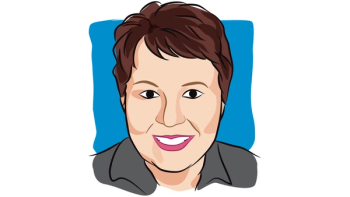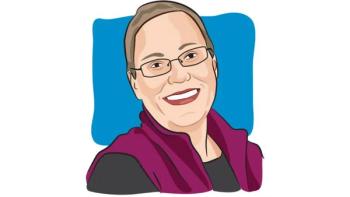
- Spring 2013
- Volume 12
- Issue 1
Risk Management: Living in the Past, Present and Future with Genetic Risk
Knowing your risk of a genetic cancer means looking to the past, living in the present and planning for the future.
Jan Byer and Amy Byer Shainman don’t look like sisters. Byer, active in the family clothing business in California, looks like a fashion designer, with 5-inch platform heels and blonde hair falling straight down her back. On the other hand, Shainman is a petite brunette who lives a more casual lifestyle with her husband and two children in Florida.
While they may not appear to be sisters in a crowd, Byer and Shainman share something more compelling than physical resemblance. In 2009 the sisters learned that they both carry an inherited mutation in the BRCA1 DNA repair gene that increases the risk for breast, ovarian and other cancers. The information came after Byer was tested when surgery at age 48 revealed not only ovarian but also uterine cancer.
The sisters knew that their paternal grandmother died at age 33 of a “female cancer” when their father was 7, and that no one in the family talked about it. The genetic counselor Byer consulted didn’t even consider her to be at risk and was surprised by the results.
Shainman, 40 at the time, says she felt like she had been waiting for some kind of information that would explain the medical notes she found in her father’s closet while looking for old pictures for a birthday scrapbook.
“They were my grandmother’s medical records, and the only word I could make out in all the flowery writing from 1934 was ‘metastases.’”
BRCA1 and BRCA2, which stand for breast cancer susceptibility gene 1 and 2, are genes expressed in cells of breast and other tissues to help repair DNA and prevent uncontrolled cell growth. If they become mutated, the damaged DNA is not repaired, leaving the woman or man at increased risk for certain cancers.
Statistics indicate that 12 percent of American women (120 out of 1,000) will develop breast cancer in their lifetime, compared with 60 percent of women (600 out of 1,000) who have inherited the BRCA1 or BRCA2 mutation. In addition, women who carry the mutated genes are at increased risk of developing breast or ovarian cancer before menopause. BRCA1 mutations may also increase a woman’s risk of developing pancreatic cancer, as well as melanoma. BRCA2 mutations increase the risk of pancreatic, stomach, gallbladder and bile duct cancers, as well as melanoma.
Men with BRCA1 mutations may be at increased risk of developing breast cancer and, possibly, pancreatic, testicular and early-onset prostate cancers. However, male breast, pancreatic and prostate cancers appear to be more strongly associated with BRCA2 gene mutations. To further complicate matters, there are numerous variations of each gene driven by ethnicity.
[Read "Can a Human Gene be Patented?"]
Victoria Seewaldt, an oncologist and director of the breast cancer prevention program at Duke Comprehensive Cancer Center in Durham, N.C., says it’s important to remember that not every woman who has a BRCA1 or BRCA2 mutation will develop breast or ovarian cancer. The mutation increases risk, she emphasizes.
“Some women have BRCA2, and they generally have the potential for an ER-positive breast cancer with a good prognosis,” Seewaldt says. “Not all BRCA are created equal.”
We want to make sure every woman with a BRCA mutation who wants to be screened has that option.
Children of a parent with a BRCA mutation have a 50 percent chance of inheriting it, Seewaldt says, but they also inherit other genes that impact whether it is activated. In other words, the mutation might be the same, but how it plays out will be different because of the person’s individual DNA and environment.
It’s a philosophy Seewaldt has adopted at the Duke clinic, where each woman in the clinic is seen as a healthy woman at risk for getting cancer, called “previvors,” and Seewaldt counsels them about aggressive screening or prophylactic surgery. Prophylactic surgery includes a bilateral mastectomy to remove most of the breast tissue and the bilateral salpingo-oophorectomy (BSO) that removes the ovaries and a good portion of the fallopian tube.
While Seewaldt is more assertive in addressing the need for prophylactic surgery with women who carry the BRCA1 mutation, she tells women with BRCA2 they have more options.
Seewaldt takes into consideration their age, whether they have children, and the mutation before she will agree to regular high-quality MRI screening as long as there is no abnormal biopsy, which will prompt a discussion with Seewaldt about prophylactic mastectomy.
“We want to make sure every woman with a BRCA mutation who wants to be screened has that option,” she says. “We have many who want to date with their breasts and want to get married with their breasts and bear children with their breasts.”
Seewaldt advises women to keep the past in the past and the future in the future and deal with what is happening now as a way to make it more manageable.
[Read about Lynch Syndrome]
Keeping the past in the past may be difficult for women such as Christina Zogg, who was 16 when her mother died in 1997 of breast cancer at age 38. Aware of no other family history in her Puerto Rican family, there wasn’t any reason to think a genetic mutation was involved. Her husband, Matt Zogg, thought she should be tested. He can’t explain why except to say he was taught to be proactive about his health.
Matt Zogg says his wife was still struggling with her mother’s death when they met at age 22. When he learned that her mother also had uterine cancer at age 28 and that a simple blood test would remove any doubt, he asked her to consider testing.
She told him no. “She didn’t know anything about it and just thought if you had the mutation you got cancer,” he says. “After our second child was born, I told her we need to take care of ourselves to be sure we are here to take care of them.”
She agreed, he says, recognizing one legacy she wanted to avoid. In December 2011, they visited a genetic counselor at Dana-Farber Cancer Institute in Boston who agreed to test. She tested positive for the BRCA2 mutation and chose aggressive screening that included MRI, mammogram, Pap smear, and transvaginal sonogram.
Putting your head in the sand and hoping something won’t happen isn’t a good strategy. Knowing what the issues are and tackling them head-on is empowering.
“Every time she was supposed to go in for a test, her stress levels were so high she wasn’t herself,” Matt Zogg says. “She finally said, ‘I can’t go on like this. I am waiting to get [cancer], and then I’ll have to go through it.’”
They subscribed to a newsletter from Facing Our Risk of Cancer Empowered (FORCE), a national nonprofit devoted to hereditary breast and ovarian cancers (facingourrisk.org), and decided to attend the organization’s October conference to learn more about prophylactic surgery.
In July 2012, Christina Zogg learned she was pregnant, and, after meeting a number of other young mothers at the FORCE conference, she decided to undergo prophylactic removal of her breasts and ovaries after the baby’s birth in April.
“The FORCE conference was incredible,” says Matt Zogg. “We met so many young previvors 25 to 35 who have had cancer or already done surgery.” The result, he says, is that his wife is more comfortable and feels more powerful now that she has a plan.
Christina Zogg has been told she can breastfeed. After she stops, she will undergo a bilateral mastectomy. The removal of the ovaries won’t occur for another year to allow time for her hormones to return to normal.
Being tested for a cancer mutation begins with a genetic counselor, says Susan Domchek, the oncologist directing The Basser Research Center for BRCA, a newly established facility at the Abramson Cancer Center at the University of Pennsylvania looks at the full spectrum of issues surrounding prevention and treatment of cancers associated with BRCA mutations. Both Domchek and Seewaldt encourage women to find a professional geneticist.
Domchek says, in addition to medical research, the facility will also investigate psychosocial issues, such as communicating with families and learning to live with risk. “We emphasize the utility of the information,” she says. “Putting your head in the sand and hoping something won’t happen isn’t a good strategy. Knowing what the issues are and tackling them head-on is empowering.”
Helping women cope with the loss of estrogen remains a challenge, Seewaldt says. Since research has shown the value of estrogen in both cardiac and bone health, she prescribes estrogen for her patients. Moreover, a study published in 2010 in the Journal of the American Medical Association—for which Domchek was lead author— indicated that women who undergo prophylactic removal of their ovaries live longer.
Once a professional geneticist is found, the challenge can be deciding who needs testing and determining that all the appropriate tests have been ordered. At present, there is no universal model for recommending testing, but the one used most often does not take into account either the paternal history or second-degree relatives, says Seewaldt. She would like to change this, pointing out that Byer received the mutation from her father, and her grandmother was a second-degree relative, which was probably why the genetic counselor Jan Byer consulted felt she didn’t need testing despite having two cancers simultaneously and being a Jewish woman of Ashkenazi (Eastern European) descent.
“It is very important not to ignore your dad’s side of the family,” Seewaldt says. “This means your dad’s sisters and brothers and their children. Breast cancer risk can be transmitted through a dad to his daughter. There is some evidence that risk transmitted through the dad might increase a woman’s risk a little more than through her mom.”
Upon learning of her status, Shainman chose to have a bilateral BSO. Both sisters were being screened with MRI for breast cancer every six months, and in January 2011, Byer showed a small malignancy. She had a bilateral mastectomy. Shainman followed with a prophylactic mastectomy in 2010.
Domchek says the individual nature of the decision can’t be stressed enough, in part because of the family dynamics and the challenges they bring. Discussing their genetic status remains a family challenge for Shainman and Byer, particularly since there are young family members who may have inherited the genetic mutation who have yet to be told.
[Read Changes in Other Genes]
Not to be forgotten are those women who test negative, she says. “There are three possible test results,” she says. “Positive is one of the known mutations, and we have a good understanding about what the different options are for those. Negative can be an incredible relief if it is what we call a ‘true negative’ like when your sister tests positive and you test negative.”
Then, she says, is the negative that really says “variance of unknown significance.” In this case, Domchek says, “We don’t know what it means.”
Articles in this issue
over 12 years ago
How Caregivers Adjust to Post-Cancer Lifeover 12 years ago
HPV-Related Cancers Risingover 12 years ago
Planning for an Unpredictable Cancerover 12 years ago
Pipelineover 12 years ago
Research Updatesover 12 years ago
Stars Team Up to Help Young Cancer Patientover 12 years ago
Tool Helps Users Prepare for End-of-Life Discussionover 12 years ago
National Women's Survivors Conventionover 12 years ago
Dr. Lacouture's Skin Care Guide for People Living with Cancer



